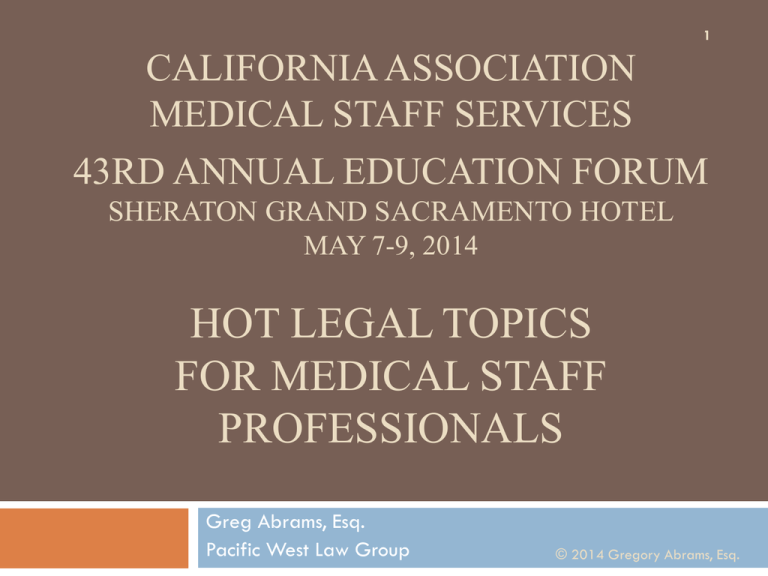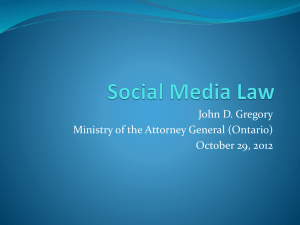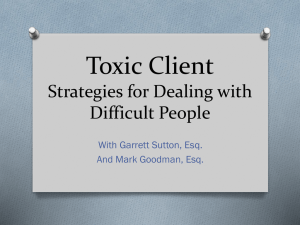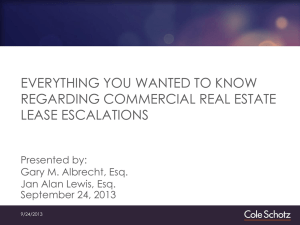Hot Legal Topics for Medical Staff Professionals
advertisement

1 CALIFORNIA ASSOCIATION MEDICAL STAFF SERVICES 43RD ANNUAL EDUCATION FORUM SHERATON GRAND SACRAMENTO HOTEL MAY 7-9, 2014 HOT LEGAL TOPICS FOR MEDICAL STAFF PROFESSIONALS Greg Abrams, Esq. Pacific West Law Group © 2014 Gregory Abrams, Esq. Topics for This Presentation 2 Possible Changes to the Medical Injury Compensation Reform Act of 1975 (MICRA), and Hospital Drug Testing of Doctors Changes to the Guidebook of the National Practitioner Data Bank Fahlen MD v. Sutter Medical Center: Supreme Court Case re Hospital Retaliation Against Whistleblower Physician on Staff © 2014 Gregory Abrams, Esq. Voter Initiative on MICRA & Random Drug Testing of Doctors 3 The Medical Injury Compensation Reform Act (MICRA): California’s medical liability reform law. Born of the mid-1970s malpractice insurance crisis: runaway jury verdicts for “pain & suffering,” skyrocketing malpractice premiums in response; Commercial malpractice carriers left California altogether, canceling all their policies; and ultimately the physician-owned carriers were created to fill the void. © 2014 Gregory Abrams, Esq. Voter Initiative on MICRA & Random Drug Testing of Doctors (cont’d) 4 What MICRA does: Permits jury verdicts to compensate malpractice plaintiff for all actual, documentable damages (lost wages, medical bills not paid by insurance, etc.) Prohibits “double recovery” – such as collecting medical expenses that a health plan already paid for plaintiff Sets a statute of limitations shorter than other kinds of lawsuits; © 2014 Gregory Abrams, Esq. Voter Initiative on MICRA & Random Drug Testing of Doctors (cont’d) 5 What MICRA does (cont’d): Places a sliding scale percentage limit on the calculation of plaintiffs’ attorneys fees, so plaintiffs would share less of an award with their attorney; Permits large money jury awards to be paid through an annuity over time, allowing for deposit of a smaller sum of money to fully compensate the patient. Permits agreement between patient and doctor for any future malpractice case to go to binding arbitration rather than the courts (less expenses for arbitration) © 2014 Gregory Abrams, Esq. Voter Initiative on MICRA & Random Drug Testing of Doctors (cont’d) 6 Probably the most important feature, the MICRA “cap”: “Pain and Suffering” damages are limited to $250,000. Has the biggest effect on limiting “runaway” jury verdicts otherwise verdicts can be in the multi-millions depending on the case with There is no consistency between the measure of emotional distress caused by the malpractice and the measure of the money damages required to “compensate” for the P&S Believed to have the biggest effect on keeping malpractice premiums lower. Also reduces the amount of money by which to calculate the plaintiff’s attorney’s fees © 2014 Gregory Abrams, Esq. Voter Initiative on MICRA & Random Drug Testing of Doctors (cont’d) 7 Arguments against MICRA: The “cap” deprives plaintiffs of their due compensation for emotional distress The “cap” harms the patients with the biggest emotional distress damages The “cap” makes it difficult for plaintiffs to get an attorney © 2014 Gregory Abrams, Esq. Voter Initiative on MICRA & Random Drug Testing of Doctors (cont’d) 8 Arguments in favor of MICRA: Plaintiffs are not deprived of their true actual documentable damages for any and all past and future medical costs Plaintiffs are not deprived of future lost wages and lifetime earning potential; © 2014 Gregory Abrams, Esq. Voter Initiative on MICRA & Random Drug Testing of Doctors (cont’d) 9 Plaintiffs are not deprived of their ability to obtain punitive damages if the lawsuit involves malicious or fraudulent acts Malpractice insurance remains expensive, even after recovery from the insurance crisis of the 70s and the institution of MICRA. © 2014 Gregory Abrams, Esq. Voter Initiative on MICRA & Random Drug Testing of Doctors (cont’d) 10 Arguments in favor of MICRA (cont’d): We cannot afford to let malpractice premiums be affected by very high “pain & suffering” jury awards, which: Raises health care costs due to higher “overhead” Reduces the ability of doctors to get malpractice insurance and cover all other costs of their practice Reduces willingness of doctors to go into high risk specialties that already have high premiums for liability coverage; © 2014 Gregory Abrams, Esq. Voter Initiative on MICRA & Random Drug Testing of Doctors (cont’d) 11 Trial Lawyers unsuccessfully attempted to increase the MICRA cap in 1998, 2000, 2012, and 2013 Latest effort to increase the cap: The Troy & Alana Pack Patient Safety Act Not qualified for the November Ballot as of April 11, 2014, but likely has enough signatures. © 2014 Gregory Abrams, Esq. Voter Initiative on MICRA & Random Drug Testing of Doctors (cont’d) 12 Initiative states up front: Drug abuse by doctors by doctors must be addressed, with one in ten MDs having drug impairment, and one third of all MDs “will experience a condition, including alcohol or drug abuse” that impairs their ability to practice safely; One third of all hospital admissions involve malpractice, and a large percentage of those cases are caused by impaired doctors; © 2014 Gregory Abrams, Esq. Voter Initiative on MICRA & Random Drug Testing of Doctors (cont’d) 13 Initiative states up front (cont’d): No mandatory drug testing exists for doctors, unlike airline pilots, bus drivers and others; There exists “no effective safeguards . . . to stop physicians from practicing until a substance abuse problem is addressed” People are harmed by doctors impaired by drugs and alcohol, and by doctors who overprescribe addictive narcotics. © 2014 Gregory Abrams, Esq. Voter Initiative on MICRA & Random Drug Testing of Doctors (cont’d) 14 Therefore, this Initiative would: Require hospitals to conduct random drug and alcohol testing of doctors Require drug testing of physicians after an unexpected death or serious injury © 2014 Gregory Abrams, Esq. Voter Initiative on MICRA & Random Drug Testing of Doctors (cont’d) 15 Require all health care practitioners to report doctors “who appear to be impaired by drugs or alcohol” Require all health care practitioners to report doctors whose patient was harmed because the doctor “failed to follow the appropriate standard of care” Require hospitals to report positive test results, suspend doctors who test positive or refuse to be tested. © 2014 Gregory Abrams, Esq. Voter Initiative on MICRA & Random Drug Testing of Doctors (cont’d) 16 Require doctors to check the CURES database for any new patient needing a Schedule II or III prescription; Adjust MICRA’s cap on pain and suffering retroactively based on inflation since 1975, and adjust it annually according to the Consumer Price Index (estimated to raise the cap to $1,100,000.) © 2014 Gregory Abrams, Esq. Voter Initiative on MICRA & Random Drug Testing of Doctors (cont’d) 17 The cap “limits the value of children’s lives” to $250K, as it does the loss due to malpractice of anyone’s quality of life, “no matter how egregious the malpractice or serious the injury.” “As a result, negligent doctors are not held accountable and patients’ safety has suffered.” © 2014 Gregory Abrams, Esq. 18 The drug provisions look like they're in the initiative to threaten doctors into supporting a MICRA reform. Its backers deny that, but their real rationale almost looks worse. The drug rules are in the initiative because they poll well, and the backers figure that's the way to get the public to support the measure. "It's the ultimate sweetener," says Jamie Court, the head of Consumer Watchdog. © 2014 Gregory Abrams, Esq. Revised National Data Bank Guidebook 19 December, 2013: The National Practitioner Data Bank (NPDB) announces the release of a draft of the revised user Guidebook. “The Guidebook is a policy manual that serves as an essential reference for Data Bank users to clarify legislative and regulatory requirements through the use of reporting and querying examples, explanations, definitions, and frequently asked questions (FAQs).” © 2014 Gregory Abrams, Esq. Revised National Data Bank Guidebook (cont'd) 20 12/27/13 – Draft of “revised user Guidebook” released for public comment; Comment period closed January 31, 2014 Unusual –> Guidebook is not law, is not regulation. New regulations from federal or state agencies require a period of “public notice and comment” before an agency can finalize a regulation. Guidebook Final version has not been released as of April 11, 2014. © 2014 Gregory Abrams, Esq. Revised National Data Bank Guidebook (cont'd) 21 This is only a guidebook, offering assistance in understanding duties in re the Data Bank to comply with law and regulation. A Guidebook is not required to have a public notice and comment period, since it is not law or regulation itself. © 2014 Gregory Abrams, Esq. Revised National Data Bank Guidebook (cont'd) 22 Draft Guidebook would revise the definition of “investigation” for purposes of reporting a physician or dentist to the National Practitioner Data Bank. Under Data Bank Rules, a physician or dentist must be reported when a physician resigns from the medical staff “while under investigation” “relating to possible incompetence or improper professional conduct, or in return for not conducting such an investigation or proceeding.” © 2014 Gregory Abrams, Esq. Revised National Data Bank Guidebook (cont'd) 23 Therefore: [1] It is important for the physician and the medical staff to know when an investigation is actually underway, and [2] It is important for the physician or dentist to know when an investigation is underway to understand the risks involved in deciding whether to resign © 2014 Gregory Abrams, Esq. Revised National Data Bank Guidebook (cont'd) 24 Page E-31 of the draft Guidebook defines what “is” and what “isn’t” an investigation: What is NOT an investigation: “A routine, formal peer review process under which the health care entity evaluates, against clearly defined measures, the privilege-specific competence of all practitioners . . . .” This sounds a lot like OPPE and routine/periodic chart reviews. © 2014 Gregory Abrams, Esq. Revised National Data Bank Guidebook (cont'd) 25 What IS an investigation, according to the draft Guidebook: When the “formal peer review process” is used because [1] issues related to professional competence or conduct are identified or . . . © 2014 Gregory Abrams, Esq. Revised National Data Bank Guidebook (cont'd) 26 When the “formal peer review process” is used because [2] monitoring of a physician’s performance is triggered “based on a single event or pattern of events related to professional competence or conduct” Does this mean a report to the NPDB is required when: a physician resigns while he is being monitored by the Physician Well-being Committee, or when a physician is being proctored for a procedure without any restrictions of doing the procedure if the proctor doesn't show up? © 2014 Gregory Abrams, Esq. Revised National Data Bank Guidebook (cont'd) 27 “An investigation begins as soon as the health care entity begins an inquiry and does not end until the health care entity’s decisionmaking authority takes a final action or formally closes the investigation.” Therefore, the period in which the mere gathering of facts is taking place does not determine when the investigation begins or ends. © 2014 Gregory Abrams, Esq. Revised National Data Bank Guidebook (cont'd) 28 A report to the NPDB must be based on evidence of: an investigation ongoing at the time of the surrender, or “evidence of a plea bargain.” Examples of acceptable evidence of “investigation”: minutes or excerpts from committee meetings, orders from hospital officials directing an investigation, notices to practitioners of an investigation. BUT, there is no requirement that the practitioner be notified or even be ©aware of the investigation. 2014 Gregory Abrams, Esq. Revised National Data Bank Guidebook (cont'd) 29 Definition of “investigation” for purposes of an NPDB report would no longer be “controlled” by what the medical staff bylaws or policies say! The medical staff bylaws has always defined “investigation,” so everyone understands when the investigation is actually underway. © 2014 Gregory Abrams, Esq. Revised National Data Bank Guidebook (cont'd) 30 Other indicators of “investigation”: The investigation must be focused on the practitioner in question. The investigation must concern the professional competence and/or professional conduct of the practitioner in question. Investigation generally should be the precursor to a professional review action. © 2014 Gregory Abrams, Esq. Revised National Data Bank Guidebook (cont'd) 31 Does this mean that an FPPE run by the department, based on a focused concern about the physician’s competence or conduct, is not an “investigation” since it is not typically “a precursor to a professional review action? © 2014 Gregory Abrams, Esq. Revised National Data Bank Guidebook (cont'd) 32 Failure to renew privileges while under “investigation”: The physician’s failure to renew clinical privileges is considered a surrender while under, or in return for not conducting, an investigation. This action must be reported to the NPDB regardless of whether the physician knew he was under investigation at the time he failed to renew his clinical privileges. A practitioner’s awareness that an investigation is being conducted is not a requirement for reporting to the NPDB. Draft Guidebook, p. E-40. © 2014 Gregory Abrams, Esq. Revised National Data Bank Guidebook (cont'd) 33 (NPDB Website, 2/7/2014) January 31 marked the end of the extended public comment period for the revised NPDB Guidebook. The Data Bank received more than 300 suggestions for changes to the draft Guidebook from more than two dozen individuals and organizations. All comments are now being reviewed in an effort to refine the draft. Once suggestions have been incorporated and the internal review process is complete, the Data Bank will post the new Guidebook on its website. The posting will be announced on the website's home page and in the Federal Register. The Data Bank thanks everyone who took the time to make suggestions that will lead to a clearer and improved NPDB Guidebook. © 2014 Gregory Abrams, Esq. California Whistleblower Protections in the Hospital 34 Health & Safety Code § 1278.5 – provides whistleblower protections for patients, healthcare workers, and “members of the medical staff” against “discrimination or retaliation” by any “entity that owns or operates a health facility,” when the person makes a report to relevant: regulatory agencies, accreditation bodies, or the hospital itself about “issues relating to the care, services, and conditions of a facility” © 2014 Gregory Abrams, Esq. California Whistleblower Protections in the Hospital 35 Also protects those same persons from “discrimination or retaliation” when they “initiate, participate, or cooperate in an investigation or administrative proceeding” carried out by a relevant government agency or accrediting body, “related to, the quality of care, services, or conditions at the facility”. The “entity that owns or operates a health facility” is the one prohibited from “discrimination or retaliation” under this statute. © 2014 Gregory Abrams, Esq. California Whistleblower Protections in the Hospital 36 Point of this legislation is “to encourage patients, nurses, members of the medical staff, and other health care workers to notify government entities [and accreditation agencies] of suspected unsafe patient care and conditions.” © 2014 Gregory Abrams, Esq. California Whistleblower Protections in the Hospital 37 Penalties for engaging in discrimination/retaliation: Civil penalty to the hospital of not more than twentyfive thousand dollars ($25,000). Misdemeanor for any person who willfully violates, and a maximum fine of $20,000. © 2014 Gregory Abrams, Esq. California Whistleblower Protections in the Hospital 38 The Statute was amended in 2005 to add protections for “members of the medical staff.” Previously was only for employees of the hospital, and did not include government agencies or accreditation bodies as possible recipients of the report. © 2014 Gregory Abrams, Esq. California Whistleblower Protections in the Hospital 39 Remedies for the medical staff member discriminated or retaliated against by the hospital: reinstatement, reimbursement for lost income resulting from any change in the terms or conditions of his or her privileges “legal costs” associated with pursuing the case, or any remedy deemed warranted by the court. © 2014 Gregory Abrams, Esq. California Whistleblower Protections in the Hospital 40 Employees (e.g., nurses): reinstatement, lost wages, and any work benefits, legal costs associated with pursuing the case “Other healthcare worker”: reimbursement for lost income and the legal costs associated with pursuing the case And/or any remedy deemed warranted by the court. © 2014 Gregory Abrams, Esq. California Whistleblower Protections in the Hospital 41 “Discrimination and Retaliation” means: discharge, demotion, suspension, or any unfavorable changes in, or breach of, the terms or conditions of a contract, employment, or privileges of the employee, member of the medical staff, or any other health care worker of the health care facility, or the threat of any of these actions. © 2014 Gregory Abrams, Esq. California Whistleblower Protections in the Hospital 42 What if the peer review process is the method used to retaliate against a physician? © 2014 Gregory Abrams, Esq. California Whistleblower Protections in the Hospital 43 February 20, 2014, California Supreme Court Case Fahlen, MD v. Sutter Central Valley Hospitals Major interpretation of the anti-retaliation statute Dr. Mark Fahlen a “kidney specialist” Employed by Gould Medical Group, Modesto Practicing at Memorial Medical Center, operated by Sutter Central Valley Hospital. © 2014 Gregory Abrams, Esq. California Whistleblower Protections in the Hospital 44 2004 – two episodes of arguing with hospital nurses allegedly failing to follow his patient treatment instructions 2006 – two more such arguments 2007-08 – six more “clashes" with certain nurses about patient care. Dr. Fahlen reported nurses’ insubordination and substandard care “on several of these occasions” © 2014 Gregory Abrams, Esq. California Whistleblower Protections in the Hospital 45 May 2008 – Hospital COO asks group medical director to talk with Fahlen. Goal was for Dr. Fahlen to “blow up” at medical director so he would be fired from group, and that Fahlen would “leave town.” COO would then not have to have peer review proceedings to get rid of Dr. Fahlen. Gould did terminate Fahlen, though apparently there was no “blow up.” But Dr. Fahlen’s malpractice insurance was canceled, “leaving him immediately unable to treat patients at © 2014 Gregory Abrams, Esq. the hospital.” California Whistleblower Protections in the Hospital 46 Dr. Fahlen asks to meet with the COO, because he wants to open his own private practice and remain at the hospital. Before the meeting, COO sends an email to the CEO that Dr. Fahlen “does not get it” – i.e., Dr. Fahlen should have understood he was going to lose his privileges at the hospital. CEO responds: “Looks like we need to have the Medical Staff take some action on his Med Quals!! Soon!!” © 2014 Gregory Abrams, Esq. California Whistleblower Protections in the Hospital 47 At their meeting, COO tells Dr. Fahlen “he should resign from the hospital and leave town, or the Hospital would begin an investigation and peer review proceedings that would result in a report to the Medical Board of California.” Dr. Fahlen does not resign, an ad hoc committee is formed and makes a report to the MEC, and the MEC recommends against renewal of Dr. Fahlen’s privileges. © 2014 Gregory Abrams, Esq. California Whistleblower Protections in the Hospital 48 Dr. Fahlen is charged with 17 counts of disruptive or abusive behavior. Peer review hearing consists of 13 sessions between October 2009 and May 2010. Six JRC physicians unanimously reverse the MEC’s decision: The evidence failed to show Dr. Fahlen was professionally incompetent or had engaged in behavior endangering the delivery of patient care. To the extent anyone’s behavior was detrimental to such care, the nursing staff was more to blame than Dr. Fahlen. © 2014 Gregory Abrams, Esq. California Whistleblower Protections in the Hospital 49 Peer Review Ruling (cont’d): Several interactions with nurses were “inappropriate and unacceptable,” but the hospital “should have intervened sooner and failed in its responsibility to do so.” Therefore, hospital “omitted to consider intermediate steps short of loss of privileges, such as anger management counseling.” © 2014 Gregory Abrams, Esq. California Whistleblower Protections in the Hospital 50 After MEC recommended terminating his privileges, Dr. Fahlen got psychological counseling, and completed anger management training – his behavior appreciably improved. Therefore, MEC “failed to sustain its burden” that termination was warranted. But JRC only recommends an outcome – hospital board is the final “decider”. . . . © 2014 Gregory Abrams, Esq. California Whistleblower Protections in the Hospital 51 Hospital board sent case back to JRC with a series of detailed questions about each alleged incident of misconduct, what the JRC’s findings were on each one, and “what evidence provided at the hearing was considered” in making the findings. JRC had 30 days to respond. JRC tells board its requests were unreasonable and that it should work off the record that it has. Hospital board votes to terminate Dr. Fahlen, saying JRC had no factual support at the hearing for its decision. © 2014 Gregory Abrams, Esq. California Whistleblower Protections in the Hospital 52 Hospital files an 805 Report. Dr. Fahlen does not go to court to overturn the Hospital board’s ruling terminating him, i.e., he does not “exhaust his remedies” Failure to exhaust remedies means the physician has accepted the peer review outcome But what if the peer review outcome is itself the retaliation prohibited under Health & Safety Code § 1278.5? Dr. Fahlen files suit under the anti-retaliation statute. © 2014 Gregory Abrams, Esq. California Whistleblower Protections in the Hospital 53 His lawsuit alleges Hospital: Caused his medical group to fire him Tried to run him out of Modesto Terminated his privileges because he complained about “substandard, insubordinate and unprofessional nursing care . . . which endangered patient care and patient safety.” He seeks reinstatement to the medical staff, lost wages, pain & suffering, attorneys fees, and punitive damages. © 2014 Gregory Abrams, Esq. California Whistleblower Protections in the Hospital 54 Hospital asserts that Dr. Fahlen cannot sue anyone or anything unless he first successfully challenges the peer review action’s result itself in court. Therefore hospital argues the civil complaint under Health & Safety Code § 1278.5 must be dismissed. Trial judge disagrees, permits the complaint to stand Appellate court agrees with Trial Court, that Dr. Fahlen does not have to exhaust his remedies first to © 2014 Gregory Abrams, Esq. bring the anti-retaliation lawsuit. California Whistleblower Protections in the Hospital 55 Supreme Court agrees that Dr. Fahlen can continue his lawsuit for retaliation under the statute: Nothing in the statute indicates the Legislature intended the exhaustion of remedies requirement to delay the ability of the physician to seek protection under the anti-retaliation statute; Wording of the statute itself shows the Legislature understood a physician could go forward with such a lawsuit while a peer review process was underway statute says the court may issue an injunction to protect an ongoing peer review process while an anti-retaliation lawsuit is underway © 2014 Gregory Abrams, Esq. California Whistleblower Protections in the Hospital 56 Peer review proceedings are not structured in their subject matter to consider whether retaliation is the basis for the proceeding They are structured to deal with competence and conduct only The standard of review on challenging a peer review outcome in court makes it very difficult for a physician to win on such a challenge © 2014 Gregory Abrams, Esq. California Whistleblower Protections in the Hospital 57 Therefore, requiring a physician to overturn the peer review proceeding itself before he could file an AR lawsuit means the physician is very unlikely to be able to exercise his right to ever challenge a retaliatory peer review This would defeat the purpose of the AR statute, which is to encourage workers in a health facility to report unsafe patient care. © 2014 Gregory Abrams, Esq. California Whistleblower Protections in the Hospital 58 This case dealt with a physician’s claim that a peer review decision to terminate his privileges was itself the act of retaliation for his whistleblowing activities. Supreme Court recognized this was not a case where: A peer review hearing was still in progress, or where A peer review decision was born of “two things true at the same time,” i.e.: Personal enmity/forbidden retaliatory motive was involved in a decision to terminate privileges, while also The peer review record nonetheless shows significant quality-of-care grounds for the adverse decision. © 2014 Gregory Abrams, Esq. California Whistleblower Protections in the Hospital 59 Under those circumstances: “Future litigants may argue that proper attention to these various concerns should affect the trial timing, the issues, and the available remedies in an individual physician’s whistleblower suit under section 1278.5. Such matters, however, are beyond the the scope of the narrow question before us here. We pass no final judgment upon them, but await their appropriate future development.” © 2014 Gregory Abrams, Esq. 60 GREG ABRAMS PACIFIC WEST LAW GROUP, LLP abrams@pacificwestlaw.com (510) 482-2845 © 2014 Gregory Abrams, Esq.






